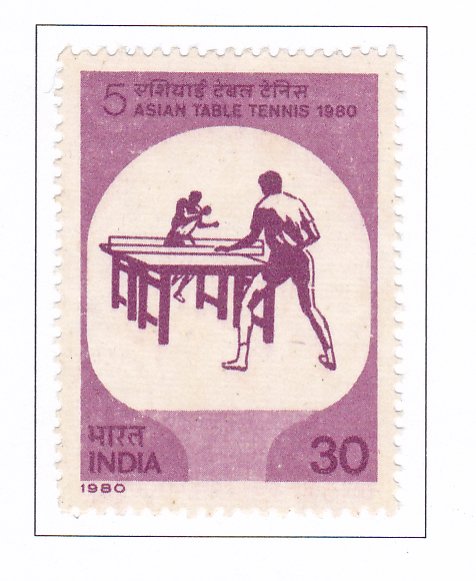5th Asian Table Tennis Championships, Calcutta

Technical Data
| Date of Issue | May 9, 1980 |
|---|---|
| Denomination | 30 p |
| Quantity | 2,000,000 |
| Perforation | comb 13 |
| Printer | Security Printing Press, Nashik |
| Watermark | Large Star and 'INDIA GOVT' (Sh) [Up] |
| Colors | Reddish purple |
| Catalog Codes |
Michel IN 825 Stamp Number IN 873 Yvert et Tellier IN 620 Stanley Gibbons IN 967 |
| Themes | Table Tennis |
Table Tennis, a lightning-fast indoor game with origins traced back to royal indoor tennis in 1880, has undergone various name changes over the years, including “Gossima” and “Ping Pong.” In 1926, the International Table Tennis Federation officially adopted the name “Table Tennis” for the sport.
Initially dominated by European players in international competitions during the 1930s, Table Tennis saw a shift in dominance to Asian players after World War II. Japan led the way in the men’s singles championship in 1952, followed by China’s first victory in 1959. Similar patterns emerged in other events like men’s doubles, women’s singles and doubles, and mixed doubles.
India has hosted the World Championships twice, first in Bombay in 1952 and then in Calcutta in 1975. The formation of the Asian Table Tennis Union in 1952 gained global recognition during the 33rd World Championship held in Calcutta in 1975.
The biennial Asian Union Championships have been held in various cities, including Beijing, Yokohama, Pyongyang, and Kuala Lumpur. The 5th Championships were scheduled to take place in Calcutta from May 10-18, 1980, under the auspices of the Bengal Table Tennis Association and the Table Tennis Federation of India.
The venue for the Championships is the Netaji Stadium in Calcutta, the largest covered stadium in India with state-of-the-art facilities and a seating capacity for about 12,000 spectators.
To commemorate this occasion, the Indian Posts and Telegraphs Department issued a special stamp. Additionally, a special cancellation service and special covers were made available at the Netaji Stadium Post Office during the Championships, offering enthusiasts the opportunity to collect unique philatelic items related to the event.
